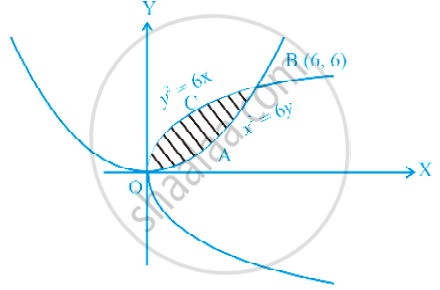Advertisements
Advertisements
प्रश्न
Using integration, find the area of the region bounded by the parabola y2 = 4x and the circle 4x2 + 4y2 = 9.
उत्तर
The area bounded by the parabola y2 = 4x and circle 4x2 + 4y2 = 9, is represented as

The points of intersection of both the curves are `(1/2,sqrt2)` and `(1/2,sqrt2)`.
The required area is given by OABCO.
It can be observed that area OABCO is symmetrical about the x-axis.
∴ Area OABCO = 2 × Area OBC
Area OBCO = Area OMC + Area MBC
`= int_0^(1/2)2sqrt"x" "dx"+int_(1/2)^(3/2) 1/2 sqrt(9-4"x"^2) "dx"`
`= int_0^(1/2)2sqrt"x" "dx"+int_(1/2)^(3/2) 1/2 sqrt((3)^2-(2"x")^2) "dx"`
Put 2x = t ⇒ dx = `"dt"/2`
When x = `3/2`, t = 3 and when x = `1/2`, t = 1
`= int_0^(1/2)2sqrt"x" "dx"+1/4int_3^1 sqrt((3)^2-("t")^2) "dt"`
`=2["x"^(3/2)/(3/2)]_0^(1/2) + 1/4["t"/2 sqrt(9-"t"^2) + 9/2sin^-1("t"/3)]_1^3`
`=2[2/3(1/2)^(3/2)]+1/4[{3/2sqrt(9-(3)^2) +9 /2 sin^-1 (3/3)}-{1/2sqrt(9-(1)^2)+9/2sin^-1(1/3)}]`
`=2/(3sqrt2)+1/4[{0+9/2sin^-1(1)}-{1/2sqrt8 +9/ 2sin^-1 (1/3)}]`
`=sqrt2/3+1/4[(9pi)/4-sqrt2-9/2sin^-1(1/3)]`
`=sqrt2/3+(9pi)/16-sqrt2/4-9/8sin^-1(1/3)`
`=(9pi)/16-9/8sin^-1(1/3)+sqrt2/12`
Therefore, the required area is `[2xx((9pi)/16-9/8sin^-1 (1/3)+sqrt2/12)]=(9pi)/8- 9/4s in^-1(1/3) +1/(3sqrt2)` sq.units.
APPEARS IN
संबंधित प्रश्न
Find the area of the region bounded by the parabola y2 = 4ax and its latus rectum.
Find the area of the region bounded by the curve \[x = a t^2 , y = 2\text{ at }\]between the ordinates corresponding t = 1 and t = 2.
Find the area of the region in the first quadrant bounded by the parabola y = 4x2 and the lines x = 0, y = 1 and y = 4.
Find the area of the region common to the parabolas 4y2 = 9x and 3x2 = 16y.
Find the area common to the circle x2 + y2 = 16 a2 and the parabola y2 = 6 ax.
OR
Find the area of the region {(x, y) : y2 ≤ 6ax} and {(x, y) : x2 + y2 ≤ 16a2}.
Find the area enclosed by the parabolas y = 5x2 and y = 2x2 + 9.
Find the area of the region in the first quadrant enclosed by x-axis, the line y = \[\sqrt{3}x\] and the circle x2 + y2 = 16.
Find the area of the region bounded by the curves y = x − 1 and (y − 1)2 = 4 (x + 1).
Using the method of integration, find the area of the region bounded by the following lines:
3x − y − 3 = 0, 2x + y − 12 = 0, x − 2y − 1 = 0.
Using integration, find the area of the triangle ABC coordinates of whose vertices are A (4, 1), B (6, 6) and C (8, 4).
Using integration find the area of the region:
\[\left\{ \left( x, y \right) : \left| x - 1 \right| \leq y \leq \sqrt{5 - x^2} \right\}\]
Find the area enclosed by the curves 3x2 + 5y = 32 and y = | x − 2 |.
Find the area enclosed by the parabolas y = 4x − x2 and y = x2 − x.
The ratio of the areas between the curves y = cos x and y = cos 2x and x-axis from x = 0 to x = π/3 is ________ .
Area bounded by parabola y2 = x and straight line 2y = x is _________ .
The area bounded by the curve y = 4x − x2 and the x-axis is __________ .
Area lying in first quadrant and bounded by the circle x2 + y2 = 4 and the lines x = 0 and x = 2, is
Find the area bounded by the parabola y2 = 4x and the line y = 2x − 4 By using vertical strips.
Find the equation of the standard ellipse, taking its axes as the coordinate axes, whose minor axis is equal to the distance between the foci and whose length of the latus rectum is 10. Also, find its eccentricity.
Using the method of integration, find the area of the region bounded by the lines 3x − 2y + 1 = 0, 2x + 3y − 21 = 0 and x − 5y + 9 = 0
Find the area of the region bounded by the parabolas y2 = 6x and x2 = 6y.
Find the area of the region enclosed by the parabola x2 = y and the line y = x + 2
Using integration, find the area of the region bounded by the line 2y = 5x + 7, x- axis and the lines x = 2 and x = 8.
Find the area bounded by the curve y = `sqrt(x)`, x = 2y + 3 in the first quadrant and x-axis.
The area of the region bounded by the curve y = `sqrt(16 - x^2)` and x-axis is ______.
The curve x = t2 + t + 1,y = t2 – t + 1 represents
Find the area of the region bounded by the curve `y = x^2 + 2, y = x, x = 0` and `x = 3`
Smaller area bounded by the circle `x^2 + y^2 = 4` and the line `x + y = 2` is.
Find the area of the smaller region bounded by the curves `x^2/25 + y^2/16` = 1 and `x/5 + y/4` = 1, using integration.
